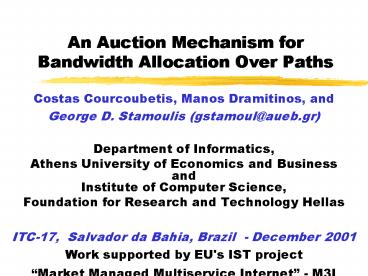An Auction Mechanism for Bandwidth Allocation Over Paths - PowerPoint PPT Presentation
1 / 17
Title:
An Auction Mechanism for Bandwidth Allocation Over Paths
Description:
An Auction Mechanism for. Bandwidth ... single and multi-unit auction mechanisms ... Develop an auction mechanism for allocation of bandwidth over ... – PowerPoint PPT presentation
Number of Views:28
Avg rating:3.0/5.0
Title: An Auction Mechanism for Bandwidth Allocation Over Paths
1
An Auction Mechanism for Bandwidth Allocation
Over Paths
- Costas Courcoubetis, Manos Dramitinos, and
- George D. Stamoulis (gstamoul_at_aueb.gr)
- Department of Informatics,
- Athens University of Economics and Business and
Institute of Computer Science, - Foundation for Research and Technology Hellas
- ITC-17, Salvador da Bahia, Brazil - December
2001 - Work supported by EU's IST project Market
Managed Multiservice Internet - M3I
2
Motivation
- Internets growth has increased the need for
bandwidth - Traditional, long-term, static bandwidth
contracts are not so popular anymore - Increased need for short-term, dynamically
requested bandwidth contracts - A new market-aware bandwidth trading mechanism is
needed
3
Auctions
- Popular trading mechanism
- Fast, fair, possibly efficient, reliable and
transparent way of setting market price - They reveal the actual market demand
- Ideal for diverse and scattered users
- e.g. users around Internet
- There exist various single and multi-unit auction
mechanisms - English, Dutch, Vickrey, 1st price sealed bid, etc
4
Open Single-unit Auctions
- English auction
- ascending bids, open-outcry
- terminates when only one bidder is left
- much information regarding demand is revealed
- Dutch auction
- descending price, open-outcry
- terminates when some bidder shouts mine
- limited information regarding demand is revealed
5
The Problem
- Develop an auction mechanism for allocation of
bandwidth over paths of a network, aiming to - exploit and satisfy demand for bandwidth, as much
as possible - for path-bidders reserve the same quantity of
bandwidth at all links of the path - Assumption
- usage of bandwidth by different users is
synchronized
6
Possible Approaches and Choices
- Independent auctions for individual links was
preferred to Combinatorial networkwide auction - due to simplicity and scalability reasons
- Open format was preferred to Sealed bid
- due to information revelation, path bidders can
develop an effective strategy - Descending-price format was preferred to
Ascending-price format - for several reasons
7
Ascending vs Descending Auctions
- Ascending auctions bidders place bids as price
per Mbps increases - Uncertainty for bidders w.r.t. final outcome
until the end - Wasteful for path-bidders
- Descending (Dutch) auctions as price per Mbps
drops, the bids placed are directly translated to
allocations - no uncertainty for bidders w.r.t. final outcome
Unknownoptimal pair of prices
p1
p2
8
Our Solution MIDAS
- Multi-unit Independent Dutch AuctionS
- A high initial price (per Mbps) is set at each
link, depending on its capacity - All prices are progressively reduced
asymmetrically, according to the demand already
expressed - When a bid is placed, the network resources
demanded are immediately allocated - Assume pay-your-bid payments ? to be revisited
Path formation facilitated
9
Price Reduction Policies (I)
- Variable Reduction Rates
- The price reduction rate at each link depends on
spare capacity - Reduction rates at different links are ordered
inversely than spare capacities - Faster decrease of prices at links with lower
demand expressed so far
10
Price Reduction Policies (II)
- Price Freezing
- The price at each link is reduces at fixed rate,
but - after an allocation, the price freezes for time
proportional to the quantity of bandwidth
allocated - Prices of different links are ordered inversely
than spare capacities, except for periods of
freezing - prices reflect market demand better than under
the Variable Reduction Rates policy
11
Example Auction Trajectory under the VRR and the
PF Policies
Prices
Prices
Link 1
Link 2
Link 1
Link 1
Link 2
PF
VRR
Spare capacities
Spare capacities
Time
Time
12
Our Policies Improve Social Welfare
(A)
3V
Link 1 users valuation 3V, total demand C0/3
Mean valuation per Mbps and per hop
V
(B)
Link 1 users valuation V, total demand 2C0/3
Path users valuation 2V e, total
demand 2C0/3
(C)
V e/ 2
e'
(D)
Link 2 users valuations e, total demand C0
- Assumption truth-telling bidders
- Symmetric Pricing ? winners A, B, D
- VRR and PF ? winners A, C, D ? higher social
welfare
13
Experiments Set-up
- Network topologies
- Linear
- Hierarchical
- Bidders utilities
14
Evaluation of MIDAS Policies with Truth-telling
Bidders (I)
15
Evaluation of MIDAS Policies with Truth-telling
Bidders (II)
- Price Freezing policy
- More efficient w.r.t. social welfare
- Variable Reduction Rates policy
- Faster
- Small sacrifice in efficiency
- The optimal (most efficient) outcome for a
network of 2 links can be computed exactly - MIDAS policies approach optimal social welfare,
typically within 5
16
Work in Progress Payment Rules and their Impact
- The payment rule affects
- bidders strategies, especially when there they
receive feedback on auction trajectory - efficiency and sellers revenue
- An incentive compatible payment rule is needed
- bidders do not benefit when not truthful
- Pay-your-bid simple but leads to bid-shading
- Stop-out pricing Each bidder is charged per link
at the price of the last winning bid for this
link - currently under investigation, both analytically
and experimentally
17
Conclusions
- Presented an auction-based approach (MIDAS) for
bandwidth allocation over paths. MIDAS - solves simply and fairly a complicated problem
- has low message- and computational overhead
- performs very well in terms of efficiency
- is transparent and scalable
- was already implemented in a software prototype
- Work in progress concerns payment rules and their
impact on MIDAS due to strategic bidding































